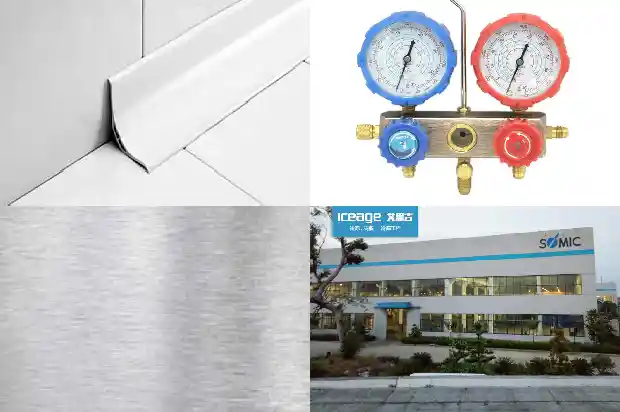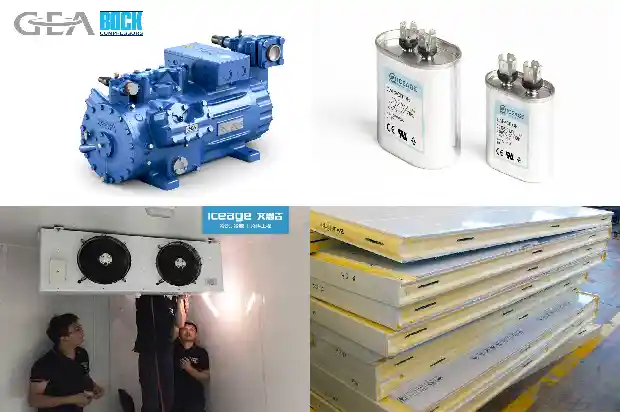Knowledge of Air Conditioning Basics and Refrigeration Principles
2025-04-30
I. Basic Refrigeration Terms
- Refrigeration: The process of removing heat from an object or fluid and discharging the heat into the environmental medium to create a temperature lower than that of the environment.
- Refrigerant: The working substance that continuously completes the cycle in the refrigeration device. Commonly used refrigerants: R22, R134A, R410A, R32, R290, R404A, R717, water.
- Secondary Refrigerant: An intermediate medium used to transfer cooling capacity in an indirect refrigeration system. Commonly used secondary refrigerants: water, brine, ethylene glycol aqueous solution.
- Refrigeration Capacity: The amount of heat transferred from a low-temperature object to a high-temperature object by a refrigerator (air conditioner) per unit time.
- Heating Capacity: The amount of heat transported indoors by an air conditioner (heat pump type) after absorbing heat from the outside per unit time.
- COP: Refrigeration capacity / compressor electrical power. Both the performance coefficient of the heat pump cycle in winter and the energy efficiency ratio of the heat pump in summer are expressed by COP (energy efficiency ratio).
- EER: Refrigeration capacity / total electrical power of the air conditioning system (The higher the EER value, the more heat is absorbed by evaporation in the air conditioner or the less electricity is consumed by the compressor). When cooling in summer, the ratio of the refrigeration capacity (W or Btu/h) to the input power (W) is defined as the energy efficiency ratio EER of the heat pump.
- Sensible Heat: During the process of a substance absorbing or releasing heat, the temperature rises or falls, but the state of the substance does not change. This kind of heat is called sensible heat.
- Latent Heat: During the process of a substance absorbing or releasing heat, its state changes, but the temperature does not change. This kind of heat cannot be measured by a thermometer, and the human body cannot feel it either, but it can be calculated through experiments. This kind of heat is called latent heat.
- Refrigeration Ton (RT): A unit in air conditioning refrigeration. The refrigeration ton is also known as the freezing ton. A freezing ton refers to the energy required to freeze one ton of water into ice. The ability to convert one ton of water at 0 degrees Celsius into ice at 0 degrees Celsius within 24 hours. The freezing ton represents the refrigeration capacity of the refrigerator.
- Horsepower (HP): The calculation of the horsepower (HP) of the air conditioning refrigeration capacity is calculated in kilocalories or watts (W). Generally, 1PH = 2000 kilocalories. When calculated in international units, it should be multiplied by 1.16.
- Unit Conversion:
1 US refrigeration ton = 3024 kcal/h = 3.517 kW;
1 Japanese refrigeration ton = 3320 kcal/h = 3.861 kW;
1 horsepower (or 1 horsepower power) = 735.5 W = 0.
7355 kW;
1 kcal/h = 1.163 W;
Celsius temperature ℃ = (Fahrenheit °F - 32) × 5/9. - Pressure: It is the force per unit area, represented by P. Its unit is Pascal, abbreviated as Pa; (Kilopascal [KPa] = 1×10³ Pa, Megapascal [MPa] = 1×10⁶ Pa)
Absolute Pressure: The pressure acting directly on the surface of a container or object.
Gauge Pressure: The pressure measured by a pressure gauge is gauge pressure.
II. Refrigeration Principle
- Refrigeration is composed of four major components: ① Compressor; ② Condenser; ③ Throttle Valve; ④ Evaporator.
The vapor is sucked into the compressor for compression, and its pressure and temperature rise to the state of superheated vapor; it enters the condenser, releases heat at constant pressure, and condenses into a liquid; the liquid coming out of the condenser passes through the expansion valve for throttling and pressure reduction, and enters the evaporator in the state of wet vapor, thus completing a cycle. - Compressor:
1.1 Positive Displacement Refrigeration Compressor: It compresses a fixed amount of gas that is periodically sucked in by changing the volume of the working chamber. Commonly used positive displacement compressors: reciprocating, rolling rotor, scroll, single screw, and twin screw types.
1.2 Centrifugal Refrigeration Compressor: It continuously compresses the sucked gas by the action of centrifugal force. - Condenser:
It cools the high-temperature and high-pressure gaseous refrigerant discharged from the refrigeration compressor and liquefies it so that the refrigerant can be recycled in the system. - Throttle Mechanism:
It throttles and reduces the pressure of the high-pressure liquid refrigerant to ensure the pressure difference between the condenser and the evaporator, so that the liquid refrigerant in the evaporator evaporates and absorbs heat under the required low pressure, thus achieving the purpose of refrigeration and cooling; at the same time, it makes the gaseous refrigerant in the condenser release heat and condense under the required high pressure.
In addition, it can adjust the flow rate of the refrigerant supplied to the evaporator to adapt to the change of the heat load of the evaporator, thus avoiding the situation that some refrigerant fails to vaporize in the evaporator. - Evaporator:
It achieves the purpose of refrigeration by the evaporation (boiling) of the refrigerant and the absorption of heat.
The Difference between the Full Liquid Evaporator and the Non-full Liquid (Dry) Evaporator:
(Dry) Type Evaporator Shell and Tube: The refrigerant of the evaporator flows inside the tube, and the water flows outside the tube bundle. The refrigerant flow usually has several passes. Due to the gradual vaporization of the refrigerant liquid, generally, the number of tubes in the passes increases as it goes upward. In order to increase the heat exchange on the water side, several baffle plates are installed on the outside of the heat transfer tubes of the cylinder to make the water flow across the tube bundle multiple times.
Its advantages are:
The lubricating oil enters the compressor along with the refrigerant, and generally, there is no problem of oil accumulation.
The amount of refrigerant charged is small, generally about 1/3 of that of the full liquid type;
When t0 is near 0°C, the water will not freeze.
Full Liquid Evaporator: The water flows inside the tube of the evaporator, and the refrigerant evaporates outside the tube bundle, so the heat transfer surface is basically in contact with the liquid refrigerant. Generally, the amount of refrigerant charged in the shell is about 55% to 65% of the effective volume of the cylinder. After the refrigerant liquid absorbs heat and vaporizes, it returns to the compressor through the liquid separator at the top of the cylinder.
Its advantages are: Compact structure, convenient operation and management, and a relatively high heat transfer coefficient.
Its disadvantages are:
When the evaporation temperature of the refrigeration system is lower than 0°C, the water inside the tube is likely to freeze and damage the evaporation tube;
The amount of refrigerant charged is large;
Affected by the height of the refrigerant liquid column, the evaporation temperature at the bottom of the cylinder is on the high side;
Oil will accumulate at the lower part of the evaporator cylinder, and reliable oil return measures must be provided; - Basics of Air Conditioning:
Air Conditioning: It is an engineering technology that adjusts and controls the state parameters of the air in a natural state within a local range according to the needs of comfort or technology.
The Main Tasks of Air Conditioning: Under the natural environment, keep the air in the regulated space at a certain temperature, humidity, flow rate, cleanliness, and freshness.
The Four Elements of Air Conditioning: Temperature, humidity, cleanliness, and air distribution are the so-called four elements of air conditioning. Adjusting these four elements can control the indoor environment to meet the comfort requirements.
Comfortable Environment: In summer, the general comfortable temperature for the human body is 24~26°C. In winter, the general comfortable temperature for the human body is 18~22°C.
Cold Shock: When cooling in summer, when the temperature difference between indoors and outdoors reaches 10 degrees, people will strongly feel the cold and heat when entering and leaving the room, making the body feel uncomfortable.
This discomfort is called "cold shock".
The temperature difference between indoors and outdoors during cooling is 3~7 degrees (the standard is 5 degrees). In no matter what occasion, the temperature difference should never exceed 10 degrees.
Classification by Purpose: Comfort type (meeting the human body's requirements for the environment); Process type (meeting the technological requirements for the environment).
Classification by Heat Transfer Medium: Water system air conditioner; Refrigerant system air conditioner.
Working Principle of Water-based Air Conditioners: The water system air conditioner is composed of an outdoor main unit and indoor terminal devices. The outdoor main unit provides air conditioning cold/hot water, which is transported to the indoor terminal devices through the water pipe system. The water and air exchange heat at the indoor terminal to eliminate the cooling/heating load of the room. It is an air conditioning system type that centrally generates cooling/heating capacity but dispersedly handles the load of each room.
Working Principle of Fluorine-based Air Conditioners: The fluorine system air conditioner uses the refrigerant as the conveying medium and adopts the variable refrigerant flow technology. The outdoor main unit is composed of an outdoor heat exchanger, a compressor, and other refrigeration accessories, and the indoor unit is composed of a direct evaporation heat exchanger and a fan. One outdoor unit can deliver refrigerant liquid to several indoor units through the pipeline. By controlling the refrigerant circulation volume of the compressor and the refrigerant flow rate entering each indoor heat exchanger, the indoor cooling and heating load requirements can be met in a timely manner.
Related Articles
- Common Knowledge of Refrigeration and Air Conditioning Systems!
- Do You Know These Commonly Used Cold Storage Knowledge?
- What Knowledge Points Should Users Know about the Safety Valve in the Refrigeration System?
- Do You Know These Basic Refrigeration Knowledge?
- Basic Knowledge of Valve - type Components in Refrigeration Systems (Technical Sharing)
- Do You Know All These Knowledges about the Absorption Unit of the Lithium Bromide Refrigeration Machine?
- HVAC - Comprehensive Knowledge You Must Know about Cooling Towers
- The Most Comprehensive Popular Science of Refrigeration and HVAC Basic Knowledge Across the Network!
- Understand These Refrigeration Knowledge to Boost Your Style!
- Basic Knowledge of Cold Storage Maintenance
- The Most Comprehensive Knowledge of Refrigeration Oil, Definitely Useful in the Future!
- Popularize Refrigeration Knowledge You've Never Noticed, Which Is Actually Very Crucial
- Practical Knowledge on Freeze Protection of Air - conditioning Equipment
- Basic Knowledge of Valve - type Components in Refrigeration Systems (Technical Sharing)
- Basic Knowledge of Cooling Towers
- Knowledge, Installation and Maintenance of Cold Storage Systems
- Obscure Knowledge of Static Pressure, Dynamic Pressure, Latent Heat and Sensible Heat in the HVAC Industry
- Fin Spacing Design of Cooler and Several Knowledge Points of Defrosting in Cold Storage
